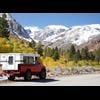This thread has wandered a bit, sort of, but electric system is so intertwined.
I'm trying to get a handle on all this especially since I am literally starting from the beginning again. My conclusion was that without a DC to DC charger and having a flooded lead engine battery and an AGM house battery bank:
1- There might be a slight delay in charging the house batteries if they were extremely low, but my thought was on a long driving day that would be moot.
2- Most alternators wouldn't be able to "top off" the AGM batteries, but one could "finish" them off with solar as long as it was sunny.
3- There is the inherit problem of having dissimilar batteries connected together
4- There is the inherit problem of having batteries of different ages.
Given the cost of a DC to DC charger, and the fact that I plan to have 200 watts of solar on the roof and 200 aHr of AGM house batteries. Couldn't I just:
1- buy a new AGM engine battery when I install the batteries in the new camper? and skip the DC to DC charger. My new to me truck is a 2016, so assuming its the original battery, its almost time to replace it anyway. The cost difference between a flooded lead and a AGM starter battery is only about $100. Plus I'd have the benefit of a starter (engine) battery that would handle vibrations better.
2- Bring larger wire to the installer and upgrade the wire from the usual 10ga that FWC does to say 6 or 8 gauge?
Somewhere in one of these threads, someone stated and I agree, that given a large solar array, and proper battery bank, you probably should need charging from your alternator anyway.
Looking forward to opinions.
First off, AGM and Flooded Lead Acid (FLA) are both lead acid chemistry batteries. Not dissimilar enough to be worrisome.
The issue with some of the isolators and thin wiring used in camper to truck connections is not just a "delay" in getting connected, it is repeated connection & disconnection. Workarounds include a simple switch to force the connection, but that doesn't get around the voltage drop that causes the disconnection in the first place. The "fix" is either thicker gauge wire or a DC-DC converter.
See what happens is that the isolator "senses" the disparate voltages present at the two battery terminals and the charging terminal. If there is enough of a charge voltage, it wants to connect them, and does. As soon as it connects, the power starts coming over the wires, and the heat of going over such a thin wire causes the voltage to "drop", and not be enough to warrant connecting them. So the isolator disconnects. And then immediately senses that there IS enough voltage to connect, and does so.... repeat. Click... Click, Click.... And not much charging happens.
Plus, many new trucks have "smart" alternators that don't produce enough voltage at to be of much use when the juice gets the 25' or so from the alternator to the camper batteries. Even with 2g wire I saw a .5 volt drop at 80A. Toyota was one of the first with this issue, and folks have used the CTEK product to get around that issue. The newer Redarc stuff looks great too, and you might even not need a separate MPPT controller at all. I like my bluetooth Victron gear though!
The reason the alternators are good for "bulk" charging is that they are relatively dumb, but big. The finesse needed for a particular battery chemistry is better left to electronics that understand the specifics for your battery.
You can certainly try to use just 200w of solar with 200AH of battery. just make sure you have a good monitor (Victron BMV) so you can tell if that's enough.
If you are going to upgrade the wire from the camper to truck, I'd think 4g is big enough. 2g was overkill in my case.


















